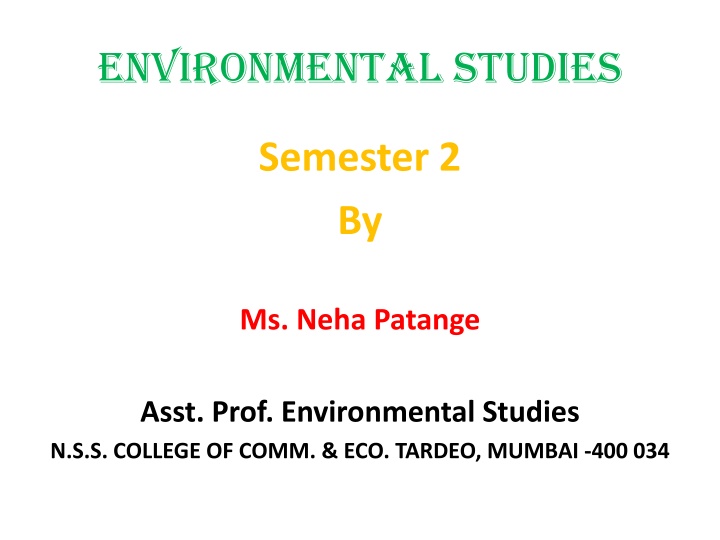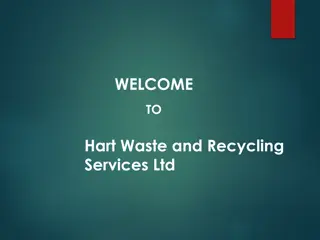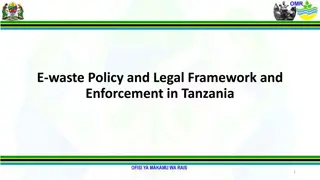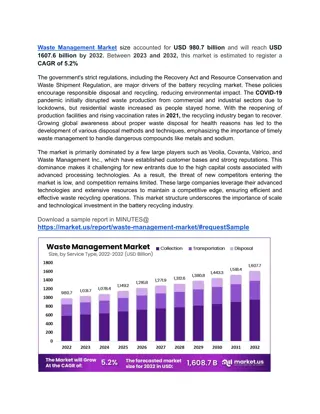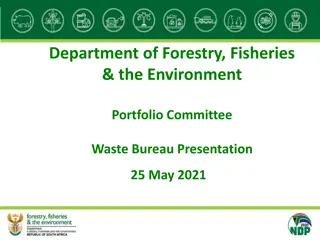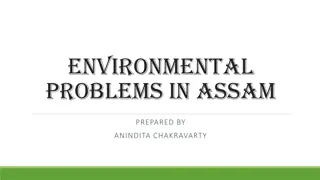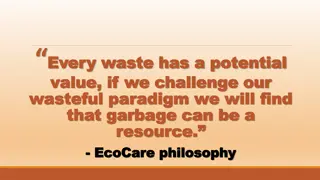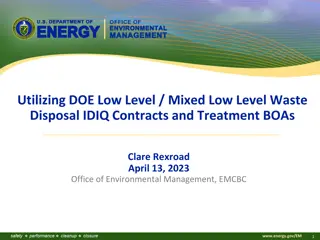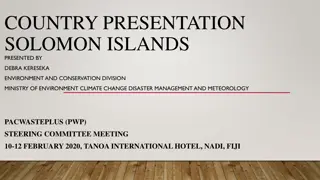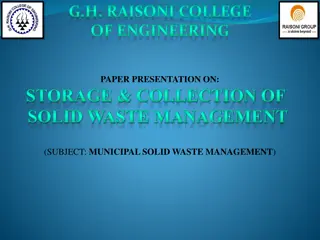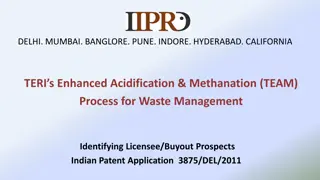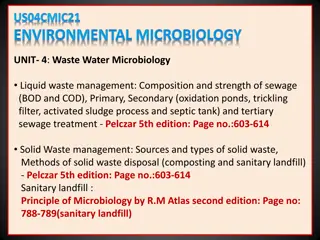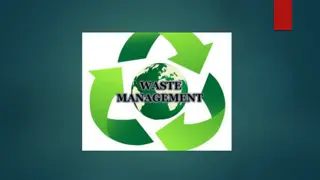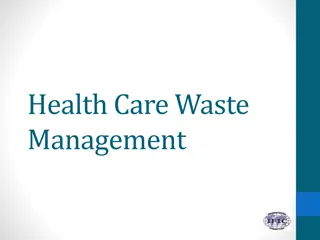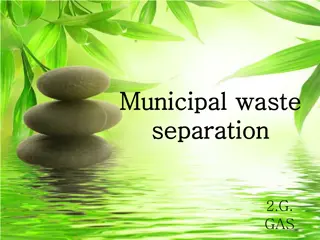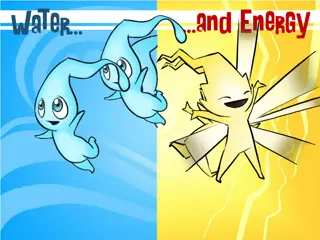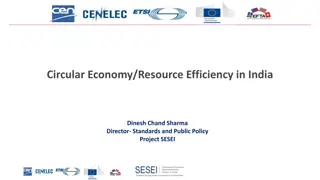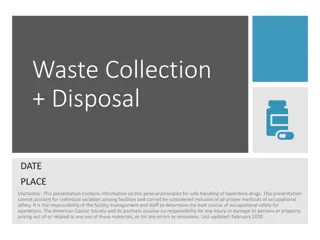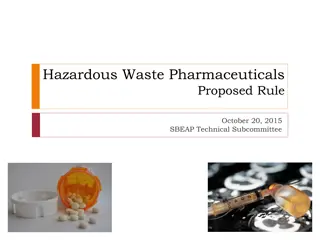Sources of Waste Generation and Management
Waste is generated from various sources such as households, industries, and agriculture. Learn about different sources of waste like medical, agricultural, industrial, construction, and electronic waste. Explore methods of solid waste management and the classification of waste.
Download Presentation

Please find below an Image/Link to download the presentation.
The content on the website is provided AS IS for your information and personal use only. It may not be sold, licensed, or shared on other websites without obtaining consent from the author.If you encounter any issues during the download, it is possible that the publisher has removed the file from their server.
You are allowed to download the files provided on this website for personal or commercial use, subject to the condition that they are used lawfully. All files are the property of their respective owners.
The content on the website is provided AS IS for your information and personal use only. It may not be sold, licensed, or shared on other websites without obtaining consent from the author.
E N D
Presentation Transcript
Environmental studies Semester 2 By Ms. Neha Patange Asst. Prof. Environmental Studies N.S.S. COLLEGE OF COMM. & ECO. TARDEO, MUMBAI -400 034
Sources of waste Sources Of Wastes Generation of waste is a part and parcel of day-to-day human life. Wastes can be generated from various sources. This includes trash or garbage from households, schools, offices, marketplaces, restaurants and other public places. Everyday items like food debris, used plastic bags, soda cans and plastic water bottles, broken furniture, broken home appliances, clothing, etc. make up the wastes generated from such sources. Medical or Clinical sources of wastes Wastes produced from health care facilities, such as hospitals, clinics, surgical theaters, veterinary hospitals, and labs are referred to as medical/clinical waste. This includes surgical items, pharmaceuticals, blood, body parts, wound dressing materials, needles and syringes Agricultural sources of wastes Waste generated by agricultural activities, including horticulture, livestock breeding, market gardens and seedling nurseries, are called agricultural wastes. Wastes generated from this source include empty pesticide containers, old silage wrap, out of date medicines and wormers, used tires, surplus milk, cocoa pods and corn husks. Industrial Sources of Wastes These are the wastes released from manufacturing and processing industries like chemical plants, cement factories, power plants, textile industries, food processing industries, petroleum industries. These industries produce different types of waste products.
Wastes from Construction or Demolition Concrete debris, wood, huge package boxes and plastics from the building materials comprise construction waste, which is yielded as a result of the construction of roads and building. Demolition of old buildings and structures also generate wastes and these are called demolition waste. Commercial Sources As a result of the advancement of modem cities, industries and automobiles, wastes are generated daily on a large scale from commercial enterprises. These may include food items, disposable medical items, textiles and much more. Mining Sources Mining activities also generate wastes that have the potential to disturb the physical, chemical and biological features of the land and atmosphere. The wastes include the overburden material, mine tailings (the waste left after extracting the ore from the rock), harmful gases released by blasting etc. Radioactive Sources Radioactive sources of wastes include nuclear reactors, mining of radioactive substances and atomic explosions. Electronic sources of waste The DVD and music players, TV, Telephones, computers, vacuum cleaners and all the other electrical stuff at your home, which are of no more use, are electronic wastes. These are also called e-waste, e-scrap, or waste electrical and electronic equipment (WEEE). Some e-waste (like TV) contains lead, mercury and cadmium, which are harmful to humans and the environment.
SWM There are different methods of solid waste management. The following are some of the recognized methods: Sanitary Landfill This is the most popular solid waste disposal method used today. Garbage is basically spread out in thin layers, compressed and covered with soil or plastic foam. Modern landfills are designed in such a way that the bottom of the landfill is covered with an impervious liner which is usually made of several layers of thick plastic and sand. This liner protects the ground water from being contaminated because of leaching or percolation. When the landfill is full, it is covered with layers of sand, clay, top soil and gravel to prevent seepage of water. Incineration This method involves burning of solid wastes at high temperatures until the wastes are turned into ashes. Incinerators are made in such a way that they do not give off extreme amounts of heat when burning solid wastes. This method of solid waste management can be done by individuals, municipalities and even institutions. The good thing about this method is the fact that it reduces the volume of waste up to 20 or 30% of the original volume.
Recovery and Recycling Recycling or recovery of resources is the process of taking useful but discarded items for next use. Traditionally, these items are processed and cleaned before they are recycled. The process aims at reducing energy loss, consumption of new material and reduction of landfills. Composting Due to lack of adequate space for landfills, biodegradable yard waste is allowed to decompose in a medium designed for the purpose. Only biodegradable waste material are used in composting. Good quality environmentally friendly manure is formed from the compost and can be used for agricultural purposes.
Global warming Global warming occurs when carbon dioxide (CO2) and other air pollutants and greenhouse gases collect in the atmosphere and absorb sunlight and solar radiation that have bounced off the earth s surface. Normally, this radiation would escape into space but these pollutants, which can last for years to centuries in the atmosphere, trap the heat and cause the planet to get hotter. That's what's known as the greenhouse effect.
Effects of global warming Ice is melting worldwide, especially at the Earth s poles. This includes mountain glaciers, ice sheets covering West Antarctica and Greenland, and Arctic sea ice. Much of this melting ice contributes to sea level rise.. Global sea levels are rising 0.13inches a year and the rise is occurring at a faster rate in recent years. Rising temperatures are affecting wildlife and their habitats. Vanishing ice has challenged species, where some populations on the western peninsula have collapsed by 90 percent or more. As temperatures change,many species are migrated Some butterflies, foxes, and alpine plants have migrated farther north or to higher, cooler areas. Precipitation (rain and snowfall) has increased across the globe, on average. Yet some regions are experiencing more severe drought, increasing the risk of wildfires, lost crops, and drinking water shortages.
Sea levels are expected to rise between 10 and 32 inches (26 and 82 centimeters) or higher by the end of the century. Hurricanes and other storms are likely to become stronger. Floods and droughts will become more common. Large parts of the U.S., for example, face a higher risk of decades-long megadroughts by 2100. Less freshwater will be available, Some diseases will spread, such as mosquito-borne malaria. Ecosystems will continue to change: Some species will move farther north or become more successful; others, such as polar bears, won t be able to adapt and could become extinct.
Methodology Landuse Wateruse Hydrology Geology Soil type Metereology Population dynamics Climate Wind pattern
Water act 1974 (1) Subject to the provisions of this Act, the main function of the Central Board shall be to promote cleanliness of streams and wells in different areas of the States. (2) In particular and without prejudice to the generality of the foregoing function, the Central Board may perform all or any of the following functions, namely,- (a) advise the Central Government on any matter concerning the prevention and control of water pollution; (b) co-ordinate the activities of the State Boards and resolve disputes among them; (c) provide technical assistance and guidance to the State Boards, carry out and sponsor investigations and research relating to problems of water pollution and prevention, control or abatement of water pollution; (d) plan and organise the training of persons engaged or to be engaged in programmes for the prevention, control or abatement of water pollution on such terms and conditions as the Central Board may specify; (e) organise through mass media a comprehensive programme regarding the prevention and control of water pollution; 15[(ee) perform such of the functions of any State Board as may be specified in an order made under sub-section (2) of section 18;] 10 (f) collect, compile and publish technical and statistical data relating to water pollution and the measures devised for its effective prevention and control and prepare manuals, codes or guides relating to treatment and disposal of sewage and trade effluents and disseminate information connected therewith;
(g) lay down, modify or annul, in consultation with the State Government concerned, the standards for a stream or well: PROVIDED that different standards may be laid down for the same stream or well or for different streams or wells, having regard to the quality of water, flow characteristics of the stream or well and the nature of the use of the water in such stream or well or streams or wells; (h) plan and cause to be executed a nation-wide programme for the prevention, control or abatement of water pollution; (i) perform such other functions as may be prescribed. (3) The Board may establish or recognise a laboratory or laboratories to enable the Board to perform its functions under this section efficiently, including the analysis of samples of water from any stream or well or of samples of any sewage or trade effluents.
Water cess act 1977 Levy and collection of cess. (1) There shall be levied and collected a cess for the purposes of the Water (Prevention and Control of Pollution) Act, 1974 (6 of 1974) and utilisation thereunder. (2) The cess under sub-section (1) shall be payable by (a) every person carrying on any 3 [industry]; and (b) every local authority,
Air Act, 1981 advise the Central Government on any matter concerning the improvement of the quality of air and the prevention, control or abatement of air pollution; plan and cause to be executed a nation-wide programme for the prevention, control or abatement of air pollution; co-ordinate the activities of the State and resolve disputes among them; provide technical assistance and guidance to the State Boards, carry out and sponsor investigations and research relating to problems of air pollution and prevention, control or abatement of air pollution; plan and organise the training of persons engaged or to be engaged in programmes for the prevention, control or abatement of air pollution on such terms and conditions as the Central Board may specify; organise through mass media a comprehensive programme regarding the prevention, control or abatement of air pollution; collect, compile and publish technical and statistical data relating to air pollution and the measures devised for its effective prevention, control or abatement and prepare manuals, codes or guides relating to prevention, control or abatement of air pollution; lay down standards for the quality of air, collect and disseminate information in respect of matters relating to air pollution; perform such other functions as may be prescribed.
Kyoto Protocol provides for three mechanisms that enable countries or operators in developed countries to acquire greenhouse gas reduction credits
Under joint implementation (JI) a developed country with relatively high costs of domestic greenhouse reduction would set up a project in another developed country.
Under the Clean Development Mechanism (CDM) a developed country can 'sponsor' a greenhouse gas reduction project in a developing country where the cost of greenhouse gas reduction project activities is usually much lower, but the atmospheric effect is globally equivalent. The developed country would be given credits for meeting its emission reduction targets, while the developing country would receive the capital investment and clean technology or beneficial change in landuse.
Under International Emmision trading (IET) countries can trade in the international carbon credit market to cover their shortfall in assigned amount units. Countries with surplus units can sell them to countries that are exceeding their emission targets under Annex B of the Kyoto Protocol.
